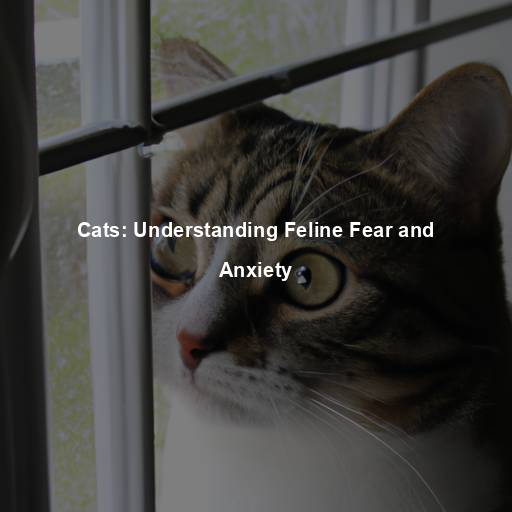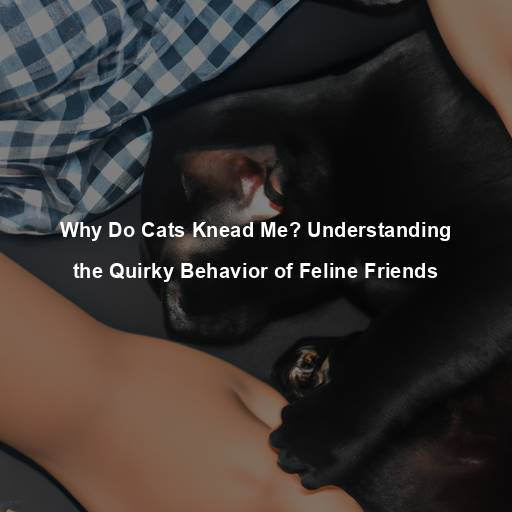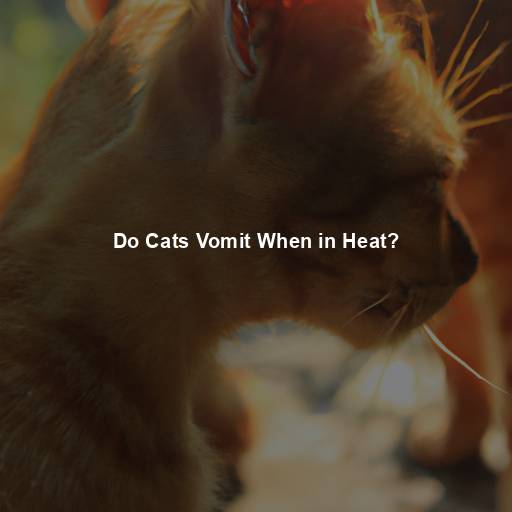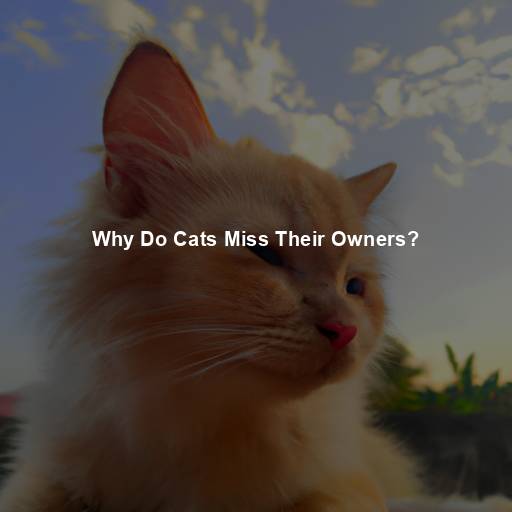Why Do Cats Jump Sideways? Understanding the Feline Phenomenon
Last Updated on July 19, 2023 by Evan
Contents
- 1 The Curious Behavior of Sideways Cat Jumps
- 1.1 Understanding the Physics of Sideways Cat Jumps
- 1.2 Hunting Instincts: A Natural Explanation
- 1.3 Acrobatics and Play: A Display of Feline Agility
- 1.4 Communication through Body Language
- 1.5 The Element of Surprise
- 1.6 Physical Conditioning and Exercise
- 1.7 Individual Differences and Personality Traits
- 1.8 The Joy of Feline Quirks
- 1.9 A Glimpse into the Wild
- 1.10 Hunting Strategies in the Wild
- 1.11 The Influence of Domestication
- 2 Exploring Possible Explanations for Sideways Cat Jumps
- 3 Tips for Encouraging Safe Play and Exercise
- 4 FAQs – Why do cats jump sideways?
The Curious Behavior of Sideways Cat Jumps
Cats have a remarkable ability to captivate us with their agility, grace, and sometimes even their quirky behaviors. One such behavior that often leaves us puzzled is their tendency to jump sideways. Whether it’s a sudden leap in pursuit of a toy or an acrobatic maneuver to evade an imaginary foe, cats seem to defy gravity as they twist mid-air. But why do they do it?
Understanding the Physics of Sideways Cat Jumps
To fully comprehend why cats exhibit this peculiar behavior, we must first examine the physics behind their jumps. Cats are incredibly agile creatures with a flexible skeletal structure, allowing them to perform impressive feats of athleticism. When executing a sideways jump, a cat relies on its powerful hind legs to generate an upward force, propelling it off the ground. As it begins its ascent, the cat twists its body mid-air, creating a rotational force that enables it to change direction effortlessly.
Hunting Instincts: A Natural Explanation
One plausible explanation for sideways cat jumps lies in their innate hunting instincts. Cats are natural predators, possessing an inherent drive to stalk and capture prey. When a cat spots a potential target, it instinctively assesses the situation, calculating the most effective approach. Sideways jumps can be seen as a strategic maneuver to outmaneuver prey or surprise them from an unexpected angle.
Acrobatics and Play: A Display of Feline Agility
Beyond their hunting instincts, sideways cat jumps also serve as a display of their impressive agility and acrobatic prowess. Cats are renowned for their remarkable flexibility and coordination, and sideways jumps provide an opportunity for them to showcase these talents. Whether it’s a playful leap to catch a feather toy or an imaginative game of chase with a fellow feline, sideways jumps allow cats to exhibit their physical abilities in a captivating and entertaining manner.
Communication through Body Language
Cats are masters of non-verbal communication, and their body language often conveys a wealth of information. Sideways jumps can be interpreted as a form of communication, expressing various emotions and intentions. For instance, a cat might execute a sideways jump as a sign of excitement or anticipation, indicating its readiness to engage in play. On the other hand, a sideways jump could also serve as a defensive gesture, signaling a desire to establish personal space or ward off potential threats.
The Element of Surprise
Another aspect to consider is the element of surprise. Cats are known for their ability to startle us with unexpected movements and actions. Sideways jumps may be a part of their repertoire to catch their human companions off guard, adding an element of excitement and unpredictability to their interactions. By incorporating sideways jumps into their play or daily routines, cats keep us on our toes and ensure that their presence never goes unnoticed.
Physical Conditioning and Exercise
In addition to their behavioral and communicative aspects, sideways cat jumps also play a role in their physical conditioning and exercise. Cats require regular physical activity to maintain their overall health and well-being. Sideways jumps provide an excellent workout for their muscles, promoting strength, agility, and coordination. By engaging in these dynamic movements, cats keep themselves physically fit, helping to prevent obesity and other related health issues.
Individual Differences and Personality Traits
It’s fascinating to witness the delightful display of feline flair when it comes to sideways jumps. However, it’s crucial to acknowledge that not all kitties share the same fervor for this particular acrobatic feat. Just like us, cats are brimming with distinct personalities and preferences that shape their playful tendencies. From the daredevil leapers to the more laid-back loungers, a variety of factors, including age, breed, temperament, and past experiences, contribute to their individual inclination towards sideways jumps.
The Joy of Feline Quirks
Sideways cat jumps possess an irresistible allure that adds an extra layer of fascination to our beloved feline companions. Whether driven by their innate hunting instincts, a playful disposition, or a need for physical activity, these acrobatic acts offer glimpses into the agility, communication, and unique character of cats. As dedicated pet owners and enthusiasts, we find joy in embracing and celebrating these idiosyncrasies, cherishing those instances of bewilderment and delight that our feline friends bring to our lives. The next time you witness your cat elegantly springing sideways, take a pause to marvel at their extraordinary capabilities and the extraordinary connection you share.
References
Discover the enigmatic world of cats in Dr. John Bradshaw’s captivating masterpiece, “Cats: The Ultimate Guide to Understanding Our Feline Friends”. Through an enthralling blend of scientific expertise and heartfelt anecdotes, this book unravels the mysterious psyche of these captivating creatures, leaving readers spellbound and enriched with a newfound appreciation for the feline kingdom. Dr. Bradshaw’s expert guidance clears the fog of uncertainty, shedding light on the most perplexing aspects of cat behavior, while simultaneously highlighting their unique bond with humans, making this an indispensable read for both passionate cat lovers and inquisitive minds alike. Embark on a journey of awe and fascination, as you delve into the lives of these majestic beings, and unlock the intricate secrets that lie within.
Get ready to unravel the enigmatic world of cats as award-winning author Claire Bessant delves deep into their mysterious ways, revealing untold secrets that will leave you astounded and perplexed. From their nocturnal escapades to their ancient feline instincts, Bessant peels back the layers of feline behavior, inviting readers on a captivating journey of discovery. Prepare to be awestruck as you uncover the hidden complexities of these enigmatic creatures and gain unparalleled insight into the secret life of cats. Throughout this enthralling read, Bessant’s exquisite narrative takes you on a rollercoaster of surprise, leaving you bursting with newfound knowledge and a deeper understanding of our beloved feline companions.
Prepare to have your mind blown as we delve into the perplexing world of feline acrobatics in Dr. Bruce Fogle’s groundbreaking book, “The Cat Encyclopedia”. Unraveling the mysteries behind the evolutionary origins of sideways cat jumps, this captivating read will leave you bursting with newfound knowledge about our favorite furry companions. From mind-boggling leaps to gravity-defying twists, Dr. Fogle’s research sets off a whirlwind of questions that will ignite your curiosity and keep you captivated until the very last page. So grab a cup of tea, sit back, and prepare to embark on a journey of sheer amazement as you uncover the secrets behind those mind-bending sideways cat jumps.
A Glimpse into the Wild
The mesmerizing sideways jumps of our feline friends have intrigued us for ages, but their origins lie deep within the evolutionary tapestry of our beloved domestic cats. In tracing their lineage, we discover a shared ancestry with majestic wild felines like the regal lions, powerful tigers, and lightning-fast cheetahs. It’s awe-inspiring to witness how these wild relatives showcase their acrobatic prowess through signature sideways jumps, paralleling the behavior of our cuddly companions. By delving into the captivating world of wild cats, we unravel the enigmatic origins of this captivating behavior in our domestic feline companions.
Hunting Strategies in the Wild
In the wild, hunting is a vital activity for survival. Cats have evolved a diverse range of hunting strategies, each tailored to their specific ecological niche. Sideways jumps can be observed in various wild cat species, serving as an effective technique to capture prey. Whether it’s an ambush predator like the leopard, waiting patiently before launching a surprise sideways attack, or a cheetah, using rapid sideways movements to outmaneuver its prey during high-speed pursuits, these behaviors showcase the versatility and adaptability of cats as hunters.
The Influence of Domestication
The domestication of cats, which occurred thousands of years ago, has undoubtedly influenced their behavior. Over time, cats have adapted to their human environments, and their hunting instincts have been shaped by their interactions with humans. While domestic cats may not rely solely on hunting for survival, their innate instincts and behaviors, including sideways jumps, persist as remnants of their wild ancestry.
Exploring Possible Explanations for Sideways Cat Jumps
Instinctive Reflexes and Muscle Memory
Have you ever wondered why cats perform those mesmerizing sideways jumps? It’s a perplexing phenomenon that leaves us in awe of their agility. As it turns out, these acrobatic leaps can be attributed to a combination of instinctive reflexes and the remarkable muscle memory that cats possess. Through the intricate process of evolution, cats have honed their neural pathways to perfection, enabling them to execute these breathtaking jumps with ease.
Spatial Awareness and Depth Perception
Cats have exceptional spatial awareness and depth perception, thanks to their well-adapted visual and sensory systems. Sideways jumps may be a result of their keen perception of distances and angles. By leaping sideways, cats can accurately gauge the distance to their target, adjusting their trajectory mid-air to ensure a successful landing. This heightened spatial awareness enables them to navigate complex environments with ease, making sideways jumps a valuable tool in their repertoire.
Flexibility and Joint Mobility
The remarkable flexibility and joint mobility of cats contribute to their ability to execute sideways jumps effortlessly. Cats have an astonishing range of motion in their spines, allowing them to contort their bodies in ways that seem almost otherworldly. Sideways jumps harness this flexibility, enabling cats to twist and turn in mid-air, adapting their position to match the demands of their surroundings. This exceptional flexibility not only facilitates their sideways jumps but also contributes to their overall grace and agility.
Behavioral Imitation and Social Learning
Have you ever wondered how cats learn those impressive sideways jumps? Well, it turns out that these observant creatures have a knack for learning through imitation. Through social learning, cats carefully watch and mimic the behaviors of their furry companions, picking up on their sideways jumping skills. It all starts when little kittens observe their mother or other adult cats during playtime or hunting adventures.
Tips for Encouraging Safe Play and Exercise
Provide Ample Play Opportunities
Cats, being creatures of unyielding instincts and boundless energy, require a suitable avenue to unleash their true potential. In order to satiate their insatiable appetite for play, it becomes paramount to bestow upon these captivating creatures a plethora of engaging opportunities. Enter the realm of interactive toys, where feline frolicking reaches new heights. From the rhythmic grace of feather wands to the mischief-inducing allure of laser pointers, and even the enigmatic enigmas presented by puzzle toys, there exists a menagerie of options to entice these enchanting beings into a state of perpetual perplexity.
Create Vertical Spaces
Cats are natural climbers, and vertical spaces provide them with opportunities to exercise and explore. Installing cat trees, shelves, or wall-mounted perches can give cats the freedom to jump and climb in a safe and controlled environment. These vertical spaces not only promote physical exercise but also provide mental stimulation and a sense of security for cats.
Rotate Toys and Enrichment Activities
Keeping cats entertained can be a challenging task, but with a bit of creativity and resourcefulness, it’s possible to combat boredom and enhance their overall well-being. By regularly changing up their toys and enrichment activities, you can ignite their curiosity and spark their desire to engage in play. Introducing new puzzle feeders, interactive games, and stimulating toys will not only prevent monotony but also cater to their unique preferences, ensuring they remain mentally and physically active.
Consider Companion Playmates
If your furry feline is craving some companionship and yearning for a workout buddy, getting them a companion cat can be a game-changer. Picture this: chase games galore, epic wrestling matches, and interactive playtime sessions that will keep them on their toes. But here’s the catch: slow and steady wins the race. Introducing new cats should be done with utmost care, ensuring their compatibility to avoid any drama or cat-astrophic conflicts.
Consult with a Veterinarian
When it comes to your furry feline friend, it’s natural to occasionally feel puzzled and uncertain about their behavior and physical activity. That’s why seeking the advice of a trusted veterinarian is crucial. These knowledgeable experts have the expertise to offer personalized guidance based on your cat’s unique requirements, ensuring that any potential health concerns that might impact their playfulness and exercise routines are effectively managed. So, if you find yourself puzzled by your cat’s behavior or questioning their exercise regimen, why not consult a veterinarian for some much-needed clarity and peace of mind?
In conclusion, sideways cat jumps are a fascinating and multifaceted behavior that combines elements of instinct, communication, and physical prowess. As we continue to unravel the mysteries of our feline friends, let us embrace their unique quirks and behaviors with curiosity and admiration. By understanding the evolutionary origins and possible explanations for sideways cat jumps, we can deepen our appreciation for the remarkable creatures that share our lives. So, the next time you witness your cat perform a sideways jump, take a moment to marvel at their agility and the wonders of nature that reside within them.
FAQs – Why do cats jump sideways?
Why do cats jump sideways?
Have you ever wondered why cats seemingly defy gravity and leap sideways? It’s a fascinating behavior with multiple reasons behind it. One notable explanation is that cats engage in sideways jumps as a form of play, tapping into their innate predatory instincts and playfully mimicking the act of pouncing on prey or engaging in a friendly skirmish. Additionally, these acrobatic leaps serve as a means for cats to let loose, expending pent-up energy while showcasing their remarkable agility and athleticism.
Is sideways jumping a sign of aggression in cats?
There’s more to sideways jumping in cats than meets the eye. Although it can be associated with aggression, it’s crucial to take into account the entire body language of our feline friends to unravel their true intentions. Look out for other warning signs like hissing, growling, a tense posture, and flattened ears to gauge if aggression is at play. However, if the cat appears at ease and playful, sideways jumping might just be a manifestation of their innate instincts rather than a sign of hostility. Let’s decode their perplexing behavior!
Do cats jump sideways when they are scared?
It’s quite fascinating how cats can exhibit such unexpected behavior when they encounter something that startles them. Instead of simply running away, they may surprise us with their sideways jumps, almost as if they’re trying to dodge the source of the disturbance. It’s believed that these reflexive, split-second reactions are their way of preserving their safety and swiftly distancing themselves from anything they perceive as a threat. It just goes to show how intricate and nuanced their instincts truly are, never failing to add an element of perplexity to their already enigmatic nature.
Can sideways jumping be a sign of pain or discomfort in cats?
Cats, those enigmatic creatures that fill our lives with both delight and puzzlement. Sometimes, these furry friends may behave in curious ways, like performing acrobatic feats that defy gravity, by jumping sideways. But hold on, before you start scratching your head in bewilderment, there could be a deeper reason behind these peculiar antics. It’s possible that your feline companion might be experiencing discomfort or pain, causing them to express themselves in unexpected ways. To truly unravel this mystery, one must cast a discerning eye on the overall behavior of our enigmatic companions, keeping an eagle-eyed watch for additional red flags. These may include anything from favoring a limb, loss of appetite, or a sudden obsession with grooming a particular area. Ah, the feline enigma deepens! If you suspect that your beloved whiskered friend may be in distress, it is advisable to seek the sage advice of a knowledgeable veterinarian, who can unlock the secrets behind these mysterious behaviors and prescribe the right path towards alleviating their pain.
Do all cats jump sideways?
It’s a wild world when it comes to feline acrobatics. While some cats may indeed embrace the side-jumping sensation, others prefer to forge their own path. It’s all about catty individuality, as these majestic creatures can’t resist showcasing their unique play-style. From straight-up leaps to forward-bound flights, there are no bounds to their whimsical ways. Age, breed, and personal quirks add yet another layer of mystique to this mesmerizing spectacle. So buckle up and witness the mesmerizing variety that defines our feline friends’ soaring adventures.







